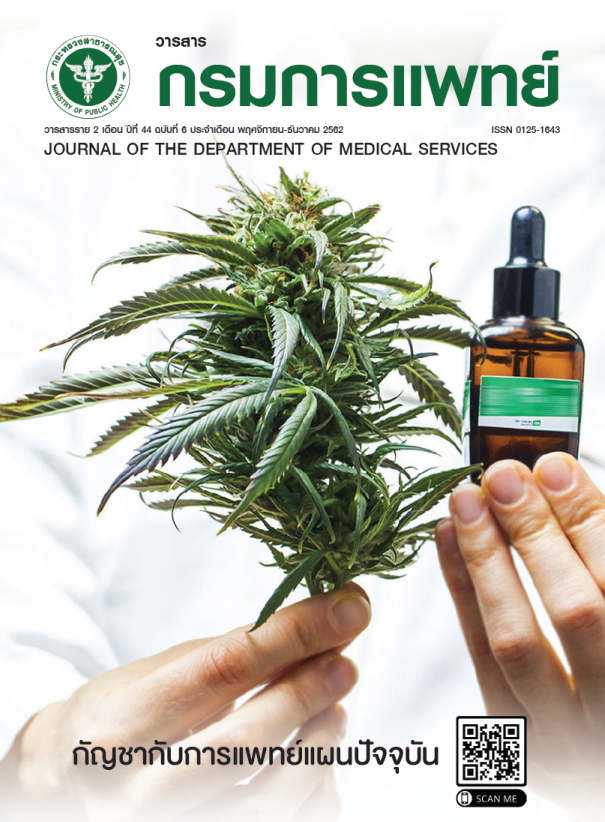กัญชากับการแพทย์แผนปัจจุบัน
Keywords:
กัญชา, แพทย์แผนปัจจุบันAbstract
พืชกัญชาใช้เป็นสมุนไพรโดยนำไปเป็นส่วนประกอบของยาแผนไทยมาตั้งแต่อดีตกาล กัญชาเมื่อผ่านการสกัดเรียกว่า“ยาที่พัฒนาจากสมุนไพร”ซึ่งเป็นลักษณะของใช้ในการแพทย์แผนปัจจุบัน สารประกอบที่ได้จากการสกัดกัญชาที่สำคัญคือสารในกลุ่ม cannabinoids ในกัญชาเรียกว่า “phytocannabi-noid”ซึ่งมีสารหลายชนิดที่ออกฤทธิ์และไม่ออกฤทธิ์ต่อจิตประสาทที่สำคัญ คือ THC (delta-9-tetrahydrocannabinol)และ CBD (cannabidiol) โดย THC ออกฤทธิ์โดยจับกับ CB และ CB receptor ในระบบประสาท มีฤทธิ์ลดอาการปวด คลื่นไส้อาเจียน กระตุ้นความอยากอาหาร แต่มีข้อพึงระวังคือ THC อาจทำให้เกิดผลต่อจิตประสาท ส่วน CBD ไม่จับกับ CB receptor จึงไม่ทำให้เกิดอาการทางจิต CBD มีฤทธิ์ต้านอาการปวด ต้านการอักเสบ ต้านอาการชัก ลดอาการเกร็ง เป็นต้น ด้วยเหตุนี้ พระราชบัญญัติยาเสพติดให้โทษ (ฉบับที่ 7) พ.ศ.2562 มีสาระสำคัญในการผ่อนปรนให้นำกัญชาซึ่งเป็นยาเสพติดให้โทษประเภทที่ 5 มาใช้ประโยชน์ทางการแพทย์ การรักษาผู้ป่วย หรือการศึกษาวิจัยและพัฒนา ซึ่งการสั่งใช้ให้กับผู้ป่วยต้องผู้ประกอบวิชาชีพเวชกรรมผู้ประกอบวิชาชีพทันตกรรมที่ผ่านการอบรมการใช้กัญชาทางการแพทย์และได้รับการขึ้นทะเบียนกับสำนักงานคณะกรรมการอาหารและยา
References
Queensland Health. Clinical guidance: for the use of medicinal cannabis products in Queensland 2018 [cited 12 March 2019]. Available from: https://www.health.qld.gov.au/__data/assets/pdf_file/0023/634163/med-cannabis-clinical-guide.pdf.
Whiting PF, Wolff RF, Deshpande S, Di Nisio M, Duffy S, Hernandez AV, et al. Cannabinoids for medical use: A Systematic Review and Meta-analysis. JAMA 2015;313:2456-73.
Smith LA, Azariah F, Lavender VT, Stoner NS, Bettiol S. Cannabinoids for nausea and vomiting in adults with cancer receiving chemotherapy. The Cochrane database of systematic reviews 2015;12:CD009464.
Devinsky O, Cross JH, Laux L, Marsh E, Miller I, Nabbout R, et al. Trial of cannabidiol for drug-resistant seizures in the Dravet Syndrome. New Engl J Med 2017;376:2011-20.
Devinsky O, Marsh E, Friedman D, Thiele E, Laux L, Sullivan J, et al. Cannabidiol in patients with treatment-resistant epilepsy: an open-label interventional trial. Lancet Neurol 2016;15:270-8.
Zajicek J, Fox P, Sanders H, Wright D, Vickery J, Nunn A, et al. Cannabinoids for treatment of spasticity and other symptoms related to multiple sclerosis (CAMS study): multicentre randomised placebo-controlled trial. Lancet 2003;362:1517-26.
Nugent SM, Morasco BJ, O’Neil ME, Freeman M, Low A, Kondo K, et al. The effects of cannabis among adults with chronic pain and an overview of general harms: a systematic review. Ann Intern Med 2017;167:319-31.
Mücke M, Weier M, Carter C, Copeland J, Degenhardt L, Cuhls H, et al. Systematic review and meta-analysis of cannabinoids in palliative medicine. J Cachexia Sarcopenia Muscle 2018; 9:220-34.
Abrams DI, Hilton JF, Leiser RJ, Shade SB, Elbeik TA, Aweeka FT, et al. Short-term effects of cannabinoids in patients with HIV-1 infection: a randomized, placebo-controlled clinical trial. Ann Intern Med 2003; 139:258-66.
Lucas CJ, GaleHis P, Schneider J. The pharmacokinetics and the pharmacodynamics of cannabinoids. Br. J Clin Pharmacol 2018; 84:2477-82.
Alsherbiny MA, Li CG. Medicinal Cannabis-Potential drug interactions. Medicines 2019; 6:3; https://doi.org/10.3390/medicines6010003.
Downloads
Published
How to Cite
Issue
Section
License
บทความที่ได้รับการตีพิมพ์เป็นลิขสิทธิ์ของกรมการแพทย์ กระทรวงสาธารณสุข
ข้อความและข้อคิดเห็นต่างๆ เป็นของผู้เขียนบทความ ไม่ใช่ความเห็นของกองบรรณาธิการหรือของวารสารกรมการแพทย์



